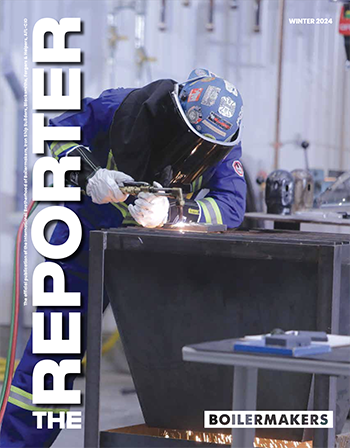Substance abuse, rigging, manpower tracking, also top agenda
PARTNERS IN THE MOST National Tripartite Alliance met at the 23rd annual conference in Myrtle Beach, S.C., Oct. 13-16 to address issues that are vital to the future of the member organizations. The alliance comprises the Boilermakers’ union, the National Association of Construction Boilermaker Employers (NACBE), and the owner community.
More than 400 alliance representatives attended.
Future of coal draws attention
A PRIMARY TOPIC was the future of coal as an energy source. Intl. Pres. Newton B. Jones opened the conference with a discussion of climate change and the search for a solution to greenhouse gas emissions. He pointed out that, at last year’s conference, alliance members were deeply concerned about the ability to supply manpower for all the coal-powered generation stations being planned. That concern has diminished somewhat today.
“If we don’t develop and implement the technologies that allow us to burn coal more cleanly, who will?”
— IP Newton B. Jones
“While we still have much work ahead of us, many of those coal-powered boiler projects have been cancelled,” he said. “What worked yesterday does not always work today, and it may not work going forward. Building coal-powered boilers to generate power worked yesterday. Today the tons of CO2 (carbon dioxide) emissions they generate are partly blamed for climate change.”
Jones outlined the various energy sources that must be a part of the future — wind, solar, hydro, wave power, natural gas, and nuclear. But he said we cannot afford to ignore 200-300 years worth of coal reserves in the United States. He stated that even if we turned our backs on coal, developing nations like China and India won’t, “and they will pump millions of tons of CO2 into our shared atmosphere.
“If we don’t develop and implement the technologies that allow us to burn coal more cleanly, who will?” he asked.
Jones called on the government to invest in clean coal technologies and on the power producers “to embrace and build clean coal power generation facilities sooner rather than later.”
Clean coal researcher describes options

Jeffrey Phillips, Ph.D., of EPRI, describes carbon capture and storage.
JEFFREY PHILLIPS, PH.D, a senior project manager with the Electric Power Research Institute (EPRI), gave the conference an overview of technologies being studied for carbon capture and storage (CCS) in the electric power industry.
He reviewed pre-combustion, post-combustion, and oxy-combustion methods of isolating CO2 at coal-powered plants. He also described how CO2 could be permanently stored deep underground in saline and depleted oil formations.
Phillips said the electric energy industry has a tremendous opportunity to recover much of the cost involved in capturing CO2. This can be done by selling CO2 to oil companies to enhance oil recovery from hard-to-reach or nearly-depleted reservoirs. In this process, CO2 is pumped into the reservoirs, forcing oil out. Enhanced extraction is not new; however, the marketing of CO2 for this purpose by electric utilities is in its infancy. Phillips cited Department of Energy estimates that there are enough oil fields that could benefit from enhanced oil extraction to handle the CO2 output of 45 500-MW, coal-fired power plants.
“That would keep more Boilermakers busy for quite a few years if we built 45 new plants with CO2 capture,” he said. “The other bonus is that if we do this, we will double U.S. oil production. So we’re solving the environmental problem, and we’re also helping the oil shortage problem.”
Building 45 new coal-fired plants with CO2 capture and using the CO2 for enhanced oil extraction would double U.S. oil production.
— Jeffrey Phillips, Ph.D., EPRI
While Phillips acknowledged that CO2 capture and storage may be costly, he said there is one way to reduce CO2 emissions that is usually overlooked. “The least costly way to improve conditions is to make a coal plant more efficient. That means if you consume less coal and produce the same amount of power, less CO2 is being produced. That means less CO2 has to be captured and compressed and put into the ground.
“To make coal power plants more efficient, we need to go to higher operating temperatures and pressures. That means more exotic materials: high-alloy, nickel-based steel. This will require new fabrication techniques. We’ll need exquisite control standards. Certainly, highly-skilled Boilermakers are going to be needed to construct these plants. The U.S. Department of Energy together with EPRI and several other organizations (including Babcock & Wilcox) are working on making a 1,400-degree F steam turbine coal plant a reality.”
Breehey discusses greenhouse gas “politics”
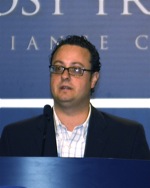
Legislative Affairs Dir. Abe Breehey talks about cap-and-trade legislation.
ABE BREEHEY, DIRECTOR of Legislative Affairs for the Boilermakers, spoke about the political implications of reducing greenhouse gas or “GHG” emissions.
Breehey noted that whether or not people agree on the existence of climate change — and mankind’s role in it — governments are accepting that something must be done. He noted that both Sen. Barack Obama and Sen. John McCain have proposed legislation to address GHG emissions.
“The goal of the Boilermakers is to shape the debate and policy in ways that are good for our union and good for our alliance partners,” he said. “That means affordable, realistic reductions in greenhouse gas emissions that minimize job losses and economic dislocations, and most importantly minimize fuel-switching for power generation from coal to natural gas.” Switching away from coal as a power source could lead to abandoning some older coal-fired power plants rather than upgrading them, costing Boilermakers future work.
The Boilermakers have been active in promoting sensible climate change policy on Capitol Hill. Breehey, who has testified before the Senate Finance Committee on this issue, said Boilermakers and the AFL-CIO support a cap-and-trade law. Such a law would create “carbon credits” and set limits on the amount of CO2 industries could emit. These limits would be lowered over time. Plants that exceed the limits would need to buy carbon credits (also called “allowances”) from those that stay below the threshold. A government auction of these allowances would create a market for industries to buy, sell, or bank the credits.
Reducing global warming emissions “could be the biggest infrastructure investment we’ve seen since the interstate highway system.”
— Abe Breehey, Director, Legislative Affairs
The overall aim of cap-and-trade is to provide an incentive for companies to reduce their CO2 emissions. It would enable them to do so gradually, so firms do not suddenly abandon older facilities, causing job loss and economic disruption.
Breehey said the Boilermakers want to see utilities receive a certain amount of free allowances. Furthermore, some of the revenues generated by cap-and-trade should be returned to the industry in the form of tax credits for carbon capture and storage as well as other technologies to reduce emissions.
He added, “If that’s the direction in which this policy moves — where we are auctioning off carbon allowances — it’s very important for our union that labor standards are part of the deal. Construction projects funded in part by revenue from the allowance auction should be covered under Davis-Bacon. This could be the biggest infrastructure investment we’ve seen since the interstate highway system.”
Progress continues on referral system upgrade
IP JONES LAID out a vision of how the Boilermaker referral process can be upgraded so that all locals use the same system, one that is automated and can be accessed from anywhere in the world where there is an Internet connection.
“In my view, the technologies are finally available to us to build a system that will accomplish all of the good things that our current system offers our members and our partners — and corrects many of the bad things that our current system allows,” he said.
The system Jones envisions will be centralized and will allow each local lodge and each individual member to have an account. Members will be able to log on to update qualifications, availability, and personal information. Dispatchers will be able to view manpower availability; sort members by classification, MOST certifications, and other criteria; and assign members to jobs in real time. Contractors will have limited access, allowing them to study manpower trends and availability. The referral system could be integrated with other automated databases such as the MOST manpower tracking system.
Jones said he will soon appoint committees to determine the criteria for referral rules, which will undergo some changes. “We will have a joint referral committee, as we do now, to make the final decision as to how the criteria will be established and how the referral system will operate. But we need to get it online; we need to get it in place. I think it will be a much better system to provide our contractors and the owner community with qualified, skilled manpower.”
To give tripartite members an idea of how a centralized, automated referral system might work, Jayne Clemance of JBS Systems demonstrated an automated traveler’s list for U.S. Boilermakers. The demo software is based on a successful traveler’s list system JBS developed for Canadian Boilermakers. Clemance showed how individuals could access and update their accounts, and how dispatchers could sort data and assign members to jobs online.
“The key benefit is that it’s easy to use,” she said. “A member can access his or her account from anywhere, even from the comfort of home. And they’ll save money and time, since they don’t have to physically travel to a lodge to add their names to a list. This will also provide locals and their dispatchers with a nationwide system of members who are willing to travel in the U.S. to work.”
Jones said the automated traveler’s list forms “the basis for the full system” that will incorporate all of the various work lists. “I think it’s going to be great for us. It’s going to solve a lot of problems that we have, simply be getting it all on one system and having it nationwide.”
Speakers address other issues
CONFERENCE PARTICIPANTS heard from speakers on a range of other topics — from substance abuse to a new rigging initiative, to the status of the manpower tracking system.
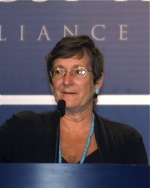
Pat Pizzo, with Kroll Laboratory Specialists, explains drug toxicology.
Pat Pizzo, director of toxicology at Kroll Laboratory Specialists, discussed drugs and alcohol from the viewpoint of job-related screening for substance abuse. She explained the effects of various drugs, the excuses people give for testing positive, false positives, and the length of time it takes commonly used drugs to clear the body.
Pizzo described some of the most dangerous drugs, including Ecstasy, which “will actually cook your body from the inside out if you overdose” and will “eat holes in your brain.”
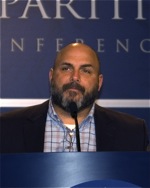
L-154: BM-ST Ray Ventrone discusses substance abuse intervention.
Ray Ventrone, Local 154 (Pittsburgh) BM, gave a report for the MOST Substance Abuse Intervention Committee. Ventrone detailed the intervention work being spearheaded by his local. He called interventions “gut-wrenching” but said they are necessary to save members with addictions and restore them to their families and their jobs. He described the operation of the Local 154 substance abuse program, which includes a support group of recovering members, a procedure for moving addicted members into rehab, post-rehab or “after care” attention, and ongoing support to keep addicts clean and sober.
Ventrone told the conference that his local is willing to assist other lodges across the country in setting up their own substance abuse committees – including traveling onsite.
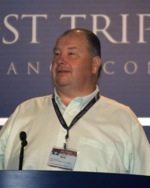
Marty Spencer, Special Asst. to the Intl. Pres., explains the new MOST rigging program.
Marty Spencer, Special Asst. to the Intl. Pres., reviewed the new rigging training program recently rolled out under the MOST umbrella. Spencer said the program has been well received. It comprises four eight-hour modules and features extensive course materials and training aids, including DVD videos, job site photos on CDs, tests, and handouts.
Spencer said train-the-trainer programs are being offered in all of the International Vice Presidential Areas. “We conducted a session in Pittsburgh (Northeast Area) in August and in Chicago (Great Lakes Area) during the last of September. The thing that struck me is the interest from the instructors at these classes. When they are this enthusiastic, you know it’s going to work.” Spencer said train-the-trainer courses for the Western States and Southeast Areas were scheduled for later in 2008.
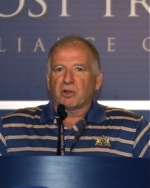
First Energy’s Larry Wargo describes a successful outage project using tripartite principles.
Larry Wargo, consultant for contractor services at FirstEnergy Corp., provided an update on the MOST manpower tracking system. The system is an initiative designed to give tripartite partners real-time data on how construction Boilermakers are allocated to projects around the country. It enables users to understand manpower demand on local, regional, and national levels. Wargo said the system now contains data from all but one or two construction locals. Current plans call for contractors and owners to get access to the system by the end of 2008.
Wargo also told conference participants about an outage at his company’s Bruce Mansfield power plant near Pittsburgh in October 2007. Because the job occurred in the peak outage season, project managers found themselves about 100 craft workers short, including about 70-80 welders. The project was on a tight, 10-week schedule. Wargo credited exceptional planning, communication, flexibility, and superb craftsmanship and production in bringing the project to completion three days early and under budget.
“The project exemplifies what the tripartite arrangement of owner, contractor, and union labor can accomplish. All three parties understood the plan, and everyone communicated throughout its execution.”
Area tripartite bodies report
THE FIVE AREA tripartite alliances provided short summaries of their operations during the last year. Making the presentations were, for the Northeast Area and the Ohio Valley, IR-GO Marty Stanton; for Eastern Canada, IR-GO Kent Oliver; for the Southeast Area, IR-GO Steve Speed; for the Upper Midwest, IR-GO Tony Palmisano; and for the Western States, AIP Kyle Evenson.
